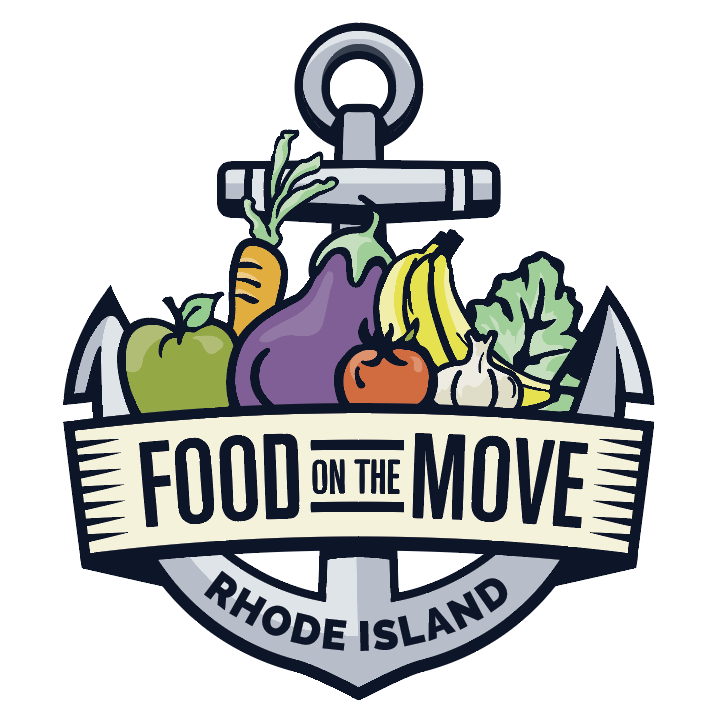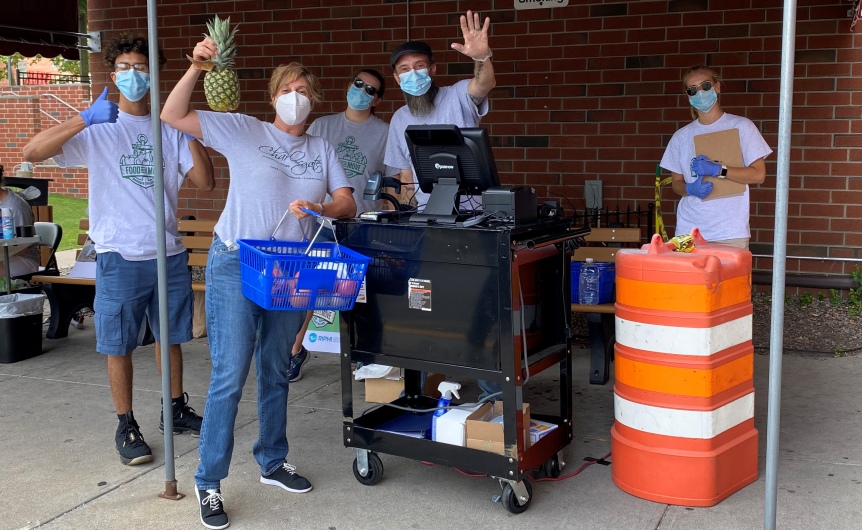Food on the Move is a year-round mobile market that sells fresh fruits and vegetables to neighborhoods throughout Rhode Island, lowering the cost of healthy food through a SNAP incentive program. It was founded in 2017 as an initiative of the Rhode Island Public Health Institute (RIPHI), whose mission is to promote community health and to eliminate health disparities in Rhode Island and beyond.
“We aim to solve complex public health challenges that affect vulnerable populations,” says Amy Nunn, executive director of RIPHI. “We use research, best public health practices, and community engagement to develop, test, and share program and policy solutions that improve population health.”
An associate professor of Behavioral and Social Sciences at the Brown University School of Public Health, Amy also has a secondary appointment in the Division of Infectious Diseases at Brown University Medical School. Food on the Move began as a research study at Brown. The study found that older adults and families with children who used the mobile markets significantly increased their fruit and vegetable consumption. Amy took over Food on the Move in 2014.
“Food on the Move is a program that produces real, tangible results in the everyday lives of our customers. Our evidence suggests that our markets help people better manage their health, increase their fruit and vegetable consumption, and help them stretch their limited food budgets further.”
When the research funding ended, RIPHI offered to seek funding and house the program in order to keep it running. That’s when Food on the Move transitioned from a research study to a community-based initiative. With a budget of approximately $350,000 a year and five employees, Food on the Move was serving people from about 10 food distribution sites and making thousands of sales, many of them to SNAP recipients. But they needed to clarify where they were headed.
“Food on the Move was growing, but we had no business plan or plan for growth,” says Amy. “The program was one hundred percent grant funded and we were unsure if there was a way to reduce reliance on grant funds. We were aware of SEG’s Accelerator program and decided to apply when we started thinking about developing a business plan and plan for expansion.”
The SEG Network Effect
Food on the Move joined SEG’s 2017 Health & Wellness Accelerator and got to work on a growth plan. They focused on better ways of using data order to improve their efficiency. They also benefited from advice provided by their SEG mentor/coach, Jim Berson, who was a valuable thought partner throughout the Accelerator.
“Jim helped us think about our value in new ways that could lead to different financial models, such as sponsorships and fundraising to better support the program,” says Amy. “He also challenged us to think differently about how we manage this program, how we prioritize our goals, and how we lead. We learned about different leadership styles, modifying communications to meet staff where they are, and strengthening our team by changing who we hire to fill the gaps in our personnel skill set.”
“We are in a better position to fundraise after completing the Accelerator. We have a written business model, have determined our funding needs, and can better articulate our value and how donors’ funds will be used to support the program.”
As a result of participating in the Accelerator, Food on the Move made a number of important decisions about the direction they wanted to take.
“We decided not to expand to new sites and instead to focus on better penetration in the sites we were already serving,” says Amy. “We are now focusing almost exclusively on older adults, which allows us to serve our population more thoroughly. We have incorporated a research and evaluation focus into the program so we can seek additional funding opportunities and disseminate our results to share knowledge and best practices with others doing similar work. We also now offer SNAP incentives on all purchases paid for with a SNAP EBT card, so our customers receive an immediate fifty percent discount on their total purchase at the point of sale.”
Food on the Move’s budget increased in 2018 and 2019 because of new grants. They’ve also been able to hire a full-time operations coordinator and a full-time research and evaluation manager. Plans are also in the works to hire a development director for RIPHI, who will help raise funds for Food on the Move.
“We are in a better position to fundraise after completing the Accelerator,” says Amy. “We have a written business model, have determined our funding needs, and can better articulate our value and how donors’ funds will be used to support the program. While we are currently serving a smaller population, the quality of our services has improved, and we have plans to scale up reach within the sites we serve. We have a very strong team and many committed partners,” she adds. “We believe our model is stronger now, and we plan to grow slowly and effectively.”
Food on the Move relaunched in July 2020 after closing down in March due to the COVID-19 pandemic. They reopened their weekly markets first at three Providence housing sites: Charlesgate North Apartments, Saint Elizabeth Place, and Hillcrest Village. Several changes to the market protocol ensures the safety of customers and employees, including holding all markets outdoors. To further reduce the risk of transmission, customers are not allowed in the produce area. Instead, the Resident Services Coordinators for each housing site gather customers’ produce based on shopping lists. All customers and staff are required to wear a mask and practice six-foot social distancing.
Food on the Move serves a diverse, older adult population that faces a number of mobility and cost-related issues in accessing nutritious food. Because many of these problems have been compounded by the new challenges brought on by COVID-19, the Food on the Move relaunch was met with great enthusiasm. Thanks to a partnership with Southside Community Land Trust, senior farmer’s market vouchers are accepted for eligible purchases of locally sourced produce.
Two goals for Food on the Move in the long term are to expand to 15 markets per week and to use their research as evidence for a statewide retail SNAP incentive program. They are conducting a longitudinal study of the program and have invested in technology to help track individualized purchasing data.
“Food on the Move is a program that produces real, tangible results in the everyday lives of our customers,” says Amy. “Our evidence suggests that our markets help people better manage their health, increase their fruit and vegetable consumption, and help them stretch their limited food budgets further.”
In a time when access to food for vulnerable populations is more critical than ever, Food on the Move market members are eager to be delivering fresh fruits and vegetables to local communities.


